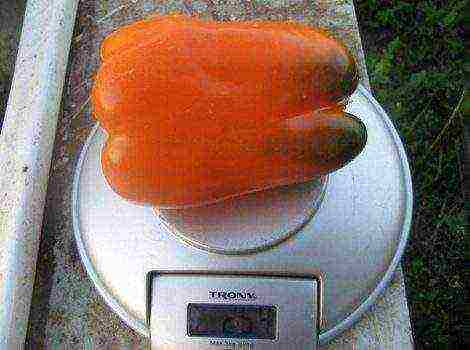Content [show]
Until recently, many believed that grapes could be grown exclusively in the southern regions. It seemed like a pipe dream to plant this plant in regions with colder climates, including the Moscow region. However, it is thanks to such "dreamers" that today there are quite a few varieties that can withstand sub-zero temperatures. They have proven that harsh winters are not a hindrance to growing these berries. Photos of the best grape varieties for the Moscow region show that the plants are developing well, and the berries grow juicy and with the necessary color. Plants are able to adapt to warm sunny summers and frosty winters.
Many gardeners are interested in what grape varieties are best planted in the Moscow region. And there are a lot of them today. The most popular varieties are described below.
Non-covering varieties
If you do not know which grape variety is better to plant in the Moscow region, pay attention to the uncovered varieties. They can withstand severe frosts (some of them up to minus 30 degrees) due to the cold snap resistance built into them by the breeders. They do not need to be covered for the winter or opened in the spring.
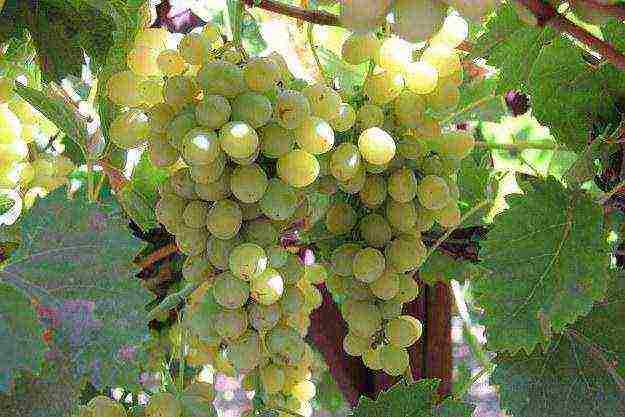
A feature of such varieties is that in the first year, the seedling must be covered. A young plant is not yet able to cope with severe frost on its own. Do not rely only on its characteristics.
The best grape varieties for the Moscow region that do not need to be covered for the winter are:
- Aleshenkin. Among gardeners, you can hear the names Alyosha or No. 328 about him. Early ripening variety (110-118 days). His bunches are conical in shape, large. Their weight varies between 0.7-2.5 kg. Large oval amber berries are covered with a light bloom. The weight of one berry is about 3-5 g. About 25-40% of the berries are pitted. The berries are juicy, sweet and crunchy.
- Harmony. The bush is able to withstand frosts down to minus 25 degrees. It takes about 135 days from budding to full maturity of the berries. Bunches are conical in medium size. Loose or medium density. The berries are dark blue, blue, round.
- Valiant will allow you to enjoy the harvest at the end of August. Frost-resistant variety (up to minus 46 degrees). Bunches are medium in size. Small blue berries with large bones have a pleasant strawberry flavor.
- Agat Donskoy. Bunches of conical shape are large, moderately dense. Their weight is in the range of 400-600 g. Large berries (up to 2.4 mm in diameter) weigh about 4-5 g. Their shape is round, the color is dark blue. The variety is resistant to frosts of minus 26 degrees.
- Laura (also called Flora). Ripens in 110-115 days.The bunches hold tightly to the shoots. This protects the berries from shedding even after full ripeness or large yields. The berries are very beautiful. They are amber in color with a slight touch of wax. The bush is not damaged at a temperature of minus 23 degrees.
- Super Extra differs in that it is able to give good yields even when grown in the shade. Ripening occurs by the end of the first decade of August (7-8 days). The vine is formed very early. Each of them can collect up to 20 kg of berries. The fruits remain on the bush even after full ripening.
- Phenomenon (you can hear such names as Augustine or Pleven stable). One of the best options, which has good taste, large beautiful berries and disease resistance. The bunches weigh about 700-800 g. Withstands frosts down to minus 24 degrees.
- Early TSHA (i.e. Northern or Pineapple). Frost-resistant (up to minus 30 degrees). The bunches are small and medium. Medium-sized round berries are blue in color with a purple bloom. A light pineapple aroma is characteristic of the juicy pulp.
- Marshal Foch. Small round berries (1.1 g). Dense cylindrical clusters of medium size have a weight of 100-120 g. Berries with a thin skin and juicy pulp have a light fruit flavor. Fruits can be harvested from early September to October. Ripening period 125 days. Frost resistance up to minus 32 degrees.
- Amber. Frost resistance minus 34 degrees. Medium-sized sweet berries gradually turn yellow. They also have a nutmeg aroma.
The list can only include the best grapes for the Moscow region, an uncovered variety. But the named will be enough to make your choice.
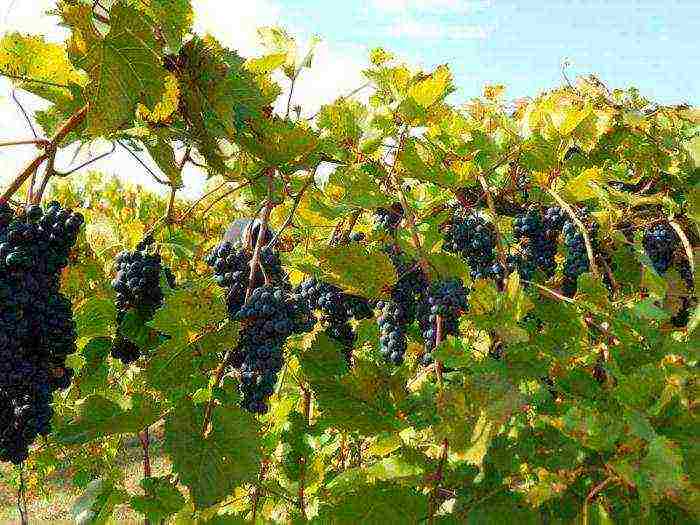
Table varieties
Next, consider which grape varieties are best planted in the Moscow region, choosing from the dining group:
- Agadai ripens in 150 days. Differs in high yields. Large clusters are conical in shape. Large oval berries have a dense flesh. Medium frost resistance. The bush is susceptible to disease. But the harvest is well kept.
- Asma. Ripening period 170 days. Bunches of medium size reach 300 g. Purple berries are large enough. Each of them contains a couple of seeds.
- Isabella with late ripening. Bunches of medium size (their weight is up to 150 g). Small black fruits with a pleasant scent reminiscent of strawberries. The bush is resistant to fungal diseases.
- The cardinal has a short growing season (120 days). Bulky bunches weigh up to half a kilogram. Large berries have a pleasant nutmeg flavor. Not resistant to disease and frost.
- The queen of the vineyards has good yields. Rounded berries form clusters of medium length.
- Odessa early, as you might guess from the name, has a short growing season. The mass of a bunch can reach 300 g. Berries with a pleasant nutmeg taste.
- Early maharacha with large clusters (up to half a kilogram). Round, dark blue fruit with a few seeds inside.
- Timur. Ripens quickly, in just 110 days. Large clusters weigh half a kilogram. Fruits grow up to 10 g. They have dense pulp, nutmeg taste. Frost resistance - up to minus 25 degrees.
- Gorgeous. Good early variety with oval pink berries. The juicy pulp has a pleasant taste. The bunches grow up to 400 g.
These are the best table grape varieties for the Moscow region. Their fruits are most often eaten in their original state, without various preparations.
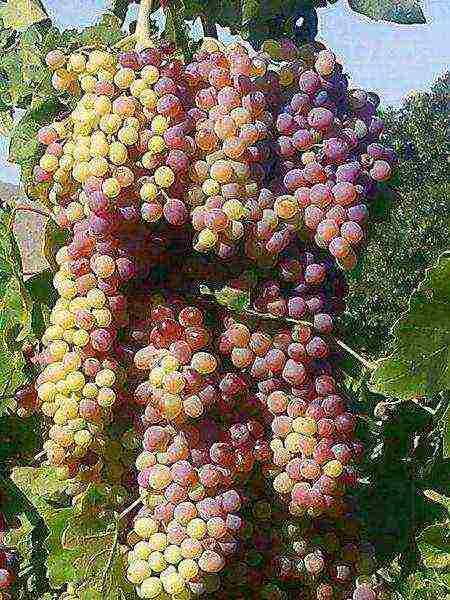
Technical grades
To the list of the best grape varieties for the Moscow region, you can add varieties related to technical:
- Rkatsiteli, from which wine with excellent aroma and taste is obtained. The variety belongs to late ripening. Bunches are medium in size. By weight they reach 180 g.
- Furmint. Mid-season variety bred by Hungarian breeders. Small clusters weigh up to 120 g. The so-called Tokyo wines are made from small berries.
- Traminer pink.It is a well-known Austrian variety for many years, which is still one of the best for wine production. Medium early grade. Rounded berries are also medium in size. The juice in them has no color. Dense clusters do not grow to large sizes. Their weight does not exceed 100 g. Partially resistant to diseases.
- Riesling. This variety is bred on the banks of the Rhine in Germany. His bunches are small (up to 100 g), but dense. The skin on small berries is thin. Disease-resistant.
These varieties are perfect for making compotes or wine.
Decorative varieties
Before deciding which grape varieties for the Moscow region are the best, you need to decide on the purpose of their cultivation. Those who want to decorate their plot, gazebos or pergolas with grapes can choose among decorative varieties. These include Northern Saperavi, Crystal, Platovsky. Plants of these varieties will delight the eye with their beauty.
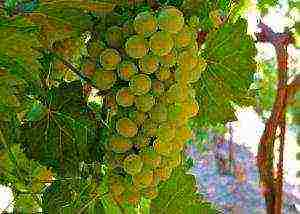
The opinion of professionals
Winegrowers have compiled their list of the best grape varieties for the Moscow region that are resistant to severe frosts:
- Juodupe. This is the earliest variety. Ripening occurs by the end of July. Its ripening period is 95-100 days. The clusters are small (up to 140 g), dense, conical in shape. Rounded, dark purple berries reach a weight of 3.2 g.
- Buffalo, which has a high yield, excellent taste and attractive large bunches.
- Early pineapple. Loose clusters reach 250 g. Fruits are large (5 g). Sweet to taste, with a pineapple flavor. The fruits can be harvested by the end of August.
- Rogachevsky. A versatile variety with a growing season of 110 days. Beautiful clusters in the form of a cylinder grow up to 300 g. Dark blue fruits weighing 5 g have a sweet taste and an isable flavor.
- K-878 or in another way Gentle. Elegant clusters are large (400 g each). The berries are pink-purple. They have a nutmeg taste.
- Lucille, which is characterized by dense clusters. They grow up to 200 g. Pink fruits (about 3 g) taste sweet. Medium-yielding variety, which ripens at the end of August. Medium-sized conical clusters.
- Ontario. The variety is distinguished by bisexual flowers, medium cylindrical clusters. Large berries have a white-greenish color, which acquires a golden hue as it ripens.
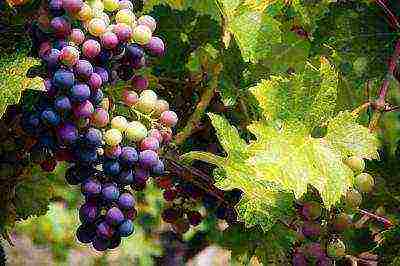
Amateur rating
Studying the reviews of the best grape varieties for the Moscow region "left by amateur gardeners, you can make the following list:
- Radiant kishmish, which is known for its lack of seeds. Differs in high productivity. Large clusters reach 1 kg. The fruit has a rich nutmeg flavor. Requires careful maintenance. It can withstand cold only up to minus 15 degrees.
- Anniversary of Novocherkassk, which is characterized by a short growing season. Pink fruits form large clusters. Frost resistant.
- The beauty of the north, with a short growing season. It is included in the group of table varieties, but has a tart taste.
- Christina. A variety with a short growing season, sweet berries. Requires little maintenance.
- Tason, possessing beautiful pink berries with white barrels. Has a nutmeg flavor. The bunches are large.
The best wine varieties
The best grape varieties for the Moscow region, suitable for making wine:
- Isabella, suitable for making dessert wines;
- Aligote, from which white wines and champagne are prepared;
- Muscat, which is used to make wines with a nutmeg flavor.
These technical varieties, which can be confidently called the best grape varieties for the Moscow region, are quite difficult to grow. But probably. All the efforts expended will more than pay off with a large harvest. And this will allow you to enjoy a pleasant delicious homemade drink.
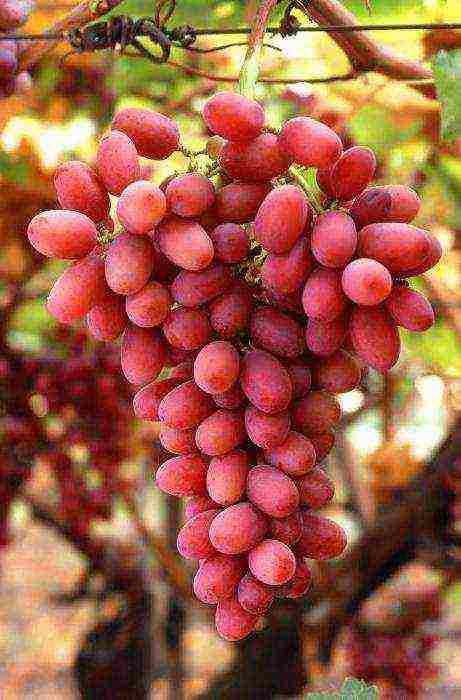
For open ground
Growing grapes is possible not only in a greenhouse.Some species are able to grow in an ordinary garden bed.
The best grape varieties for the Moscow region for open ground:
- Summer muscat with excellent taste. Short growing season. Frost resistance is ensured by good maturation of the vine.
- Victoria (some people mistakenly call him Uehara). Refers to table varieties with a short growing season. Frost resistance up to minus 30 degrees. The bunches are large, weighing up to 800 g. Raspberry-red berries resemble an egg in shape. The fruit is sweet with a nutmeg flavor. Differs in high productivity.
- Nadezhda Aksayskaya. It is characterized by large bunches and berries. It tastes like Arcadia berries. Differs in a shorter ripening period. The crop can be harvested from mid-August.
- Shun, which is one of the best options. Resistant to winter cold. The berries are large (up to 6-7 g). The bunches are red, turning to dark pink as they ripen. The berries ripen by the end of August. The variety is resistant to diseases.
Tips for Beginner Winegrowers
Having decided what are the best grape varieties for the Moscow region, you can start growing them. But here, too, there are a few key points to consider.
The most important thing for a good harvest is to provide the plant with the right amount of water and nutrients. In the Moscow region, groundwater is close to the soil surface. Therefore, it is necessary to water the grapes very rarely. As for fertilizing, it is necessary to exclude nitrogen fertilizers. The fact is that nitrogen stimulates the rapid growth of the vine. She does not have time to ripen before autumn and the onset of the first frost. This leads to freezing of the entire bush and a decrease in yield. All other types of fertilizers are applied in accordance with the selected variety.
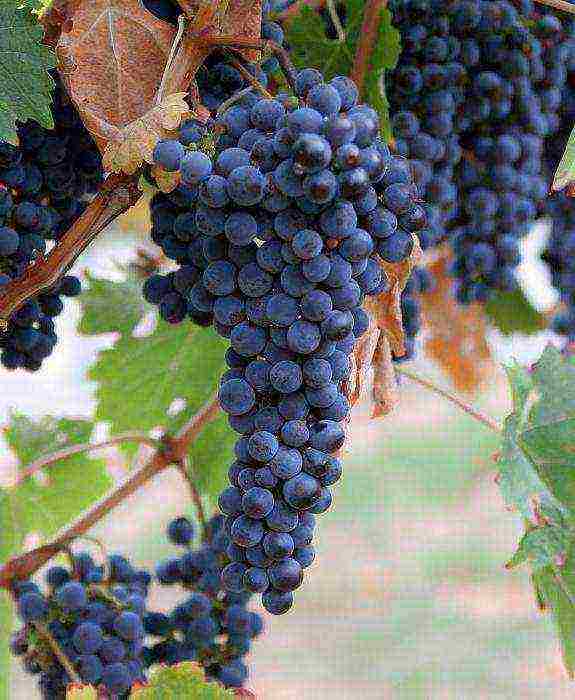
It is best to plant grapes on light sandy loam soil. The first spring rays of the sun easily warm it up. And in the fall, the soil cools down, giving the plant the opportunity to prepare for the cold.
If the selected best grape variety for the Moscow region has poor frost resistance, the bush must be protected from frost. This applies not only to the winter period, but also to spring frosts. During cold weather, all shoots are removed from the mount and laid on the ground. If this is not done, the plant will definitely freeze. The base of the trunk is covered with a special garden film. But the usual methods are fine too. For example, mulching with a thick layer of sawdust. Fallen leaves should not be used. They can be carriers of various diseases. They are recommended to be burned.
Conclusion
As can be judged from the article, the answer to the question of which grape varieties are best planted in the Moscow region is not so difficult to find. The growers took care of creating a wide variety of varieties that are suitable for growing in the Moscow region (and other regions with a similar climate). Due to the difficult growing conditions, the plants are resistant to fungal diseases. And thanks to this, the yield increases.
It is important to remember one more point: even the best grape variety chosen for the Moscow region cannot give a good harvest without proper attention and care. In addition to the introduction of nutrients, the bush requires regular pruning, treatment from diseases and pests, and shelter for the winter.
To grow grapes in the Moscow region without much hassle, it is necessary to select the right varieties. They must be frost-hardy and yield crops before the onset of frost. In the article we will tell you about the best grape varieties for the Moscow region, consider which of them is more suitable for the Moscow region climate.
Features of the climatic conditions of the Moscow region
Grapes are a thermophilic crop, but thanks to the efforts of breeders, they began to grow it in the South, North and Central region. The climate near Moscow is not the best for grapes, but more suitable than the northern one. The first half of summer is hot, and the second is most often rainy.Rains during the ripening period of the grapes are not desirable, because the fruits crack and rot.
The earlier grapes ripen in the Moscow region, the better. It is for this reason that early varieties are chosen for the region. Despite unfavorable weather conditions, the Moscow Region has advantages for grapes over the South, namely:
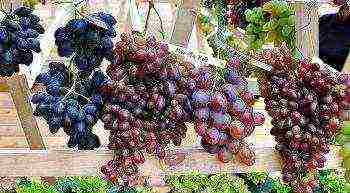
For the Moscow region, there are many early ripening varieties with good taste characteristics.
- good yield of varieties;
- a small number of diseases;
- low pest activity;
- easier vineyard care;
- many varieties.
Since the spring in the Moscow region can be protracted, and the winter is harsh, only frost-resistant varieties are chosen. There are frost-resistant varieties that are resistant to diseases and pests and easily tolerate spring frosts. For Siberia and the Urals, ideal varieties are wine, for example Lydia.
| Moscow suburbs | Siberia | Ural |
| Agate Donskoy, Beauty of the North, Rusven, Crystal, Christina, Kishmish Radiant variety overview | Velika, Golden Potapenko, Ruslan, Riddle, Pearl Saba | Lydia, Aleshenkin, Beauty of the North, In memory of Dombkovskaya, Muscat |
5 best grape varieties for the Moscow region
The Christina variety is unpretentious in care, therefore it is popular among winegrowers in the Moscow region.
Despite the changeable climate, grapes in the Moscow region give a good harvest, even better than in the South. New varieties do not get sick and are not afraid of the cold. There are many grape varieties, but there are only four tastes: sweet, nutmeg, sweet and sour and nightshade.
We offer a rating of varieties:
- Anniversary of Novocherkassk. An early variety, resistant to frost. The bunches are large, sweet, pink berries.
- Kishmish Radiant. This variety is obtained by crossing the Cardinal and Kishmish Pink grapes. The advantages include high yield, bunch weight up to 1 kg, rich nutmeg taste and shoot fertility up to 70%. Besides the advantages, there are also disadvantages. Kishmish is fastidious in care and is afraid of frost, tolerates temperatures down to -15 degrees. Read also the article: → "Evaluation and description of the radiant raisin grape variety."
- Beauty of the North. This is a table variety. The advantages include early ripening, the disadvantages - the tart taste of berries.
- Tason. A variety with large bunches. Berries with nutmeg flavor, pink with white sides.
- Christina. Mid-season variety. The advantages include unpretentious care and sugar content of berries.
In addition to the above varieties, Super Extra, Rusven, Agat Donskoy and Crystal are popular. Among the whole variety of varieties, only seedless Kishmish grapes. When grown in the Moscow region, Kishmish needs shelter before the onset of autumn frosts. Cover the vine with agrofibre before frost.
The best wine varieties
The fruits of the Krasa Severa variety ripen in August.
Grapes are grown for more than just food. It is difficult to grow decent grapes in the Moscow region for making a good wine drink, but it is possible. Popular technical varieties near Moscow include the following:
- Isabel. Dessert wines are made from grapes.
- Aligote. Suitable for making white wines and champagne. A late ripening variety that needs shelter.
- Muscat. The drinks have a nutmeg aroma and aftertaste.
Isabella is often confused with the Alpha variety. This is a technical grade that is suitable for the Moscow region. Fruits ripen in September-October. Bunches up to 200 g, dark blue berries. The bushes do not tolerate drought, but they are frost-resistant. Despite the late ripening, the vineyard gives a good harvest. Refers to non-covering varieties.
The Isabella variety is the best for the Moscow region, it does not need shelter.
In the Moscow region, grapes of the Crystal and Rusven varieties are also grown. Among the technical varieties, Crystal is the earliest. The fruits of the Kristall variety ripen in 100-115 days. The mass of a bunch is up to 200 g. Berries are yellow-green, ripen well in the Moscow region.
The benefits include:
- up to 90% of shoots bear fruit;
- sugar content up to 18%;
- winter hardiness up to - 29 ºС;
- resistance to gray mold.
Dry wines are made from the fruits of the Crystal variety. Rusven grapes are also an early variety. Ripens in 115 days. Sugar content up to 20%. The bushes are resistant to frost down to - 27 ºС and fungal diseases. Dessert and table wines are made from the fruits of this variety.
Tip # 1. The thickening of the shoots of technical grape varieties leads to a decrease in yield and winter hardiness, so they must be cut off.
Popular early and mid-season varieties
For the Moscow region, only early and middle varieties are suitable, and even then not all mid-season vineyards have time to ripen before the onset of frost. We offer in the table popular varieties of different ripening periods.
| Ripening period | Variety |
| Early | King of the North, Anniversary of Novocherkassk, Summer Muscat, Tason, Super Extra |
| Mid-season | Kishmish Radiant, Christina, Augustine |
Not all varieties are frost-resistant, therefore they need shelter for the winter. Tason fruits ripen in 100-110 days. The weight of the bunches is 600 g, and in some cases even 1.2 kg. More than half of the shoots bear fruit, due to this, a good harvest is harvested from the bush. Harvested in the first half of August. The variety is frost-resistant, withstands temperatures up to - 23 ºС, resistant to mildew, gray mold and powdery mildew.
Agate Donskoy is classified as a mid-season variety. The crop ripens in 120 days. Disadvantages include sour taste and unsuitability for transportation. The advantages of the variety include:
- large clusters up to 600 g;
- up to 80% of the shoots are fruitful;
- frost resistance up to -26 ºС;
- good survival rate in adverse climatic conditions.
Other varieties are also popular:
- Super Extra belongs to the early varieties. The fruits ripen in the first half of August.
- Augustine is a mid-season variety. The fruits ripen by the end of August, the vine has time to ripen before frost. The variety is frost resistant. The fruits are oval and sweet.
- Summer Muscat is an early variety. Bunches weighing up to 1 kg, large, yellow fruits. Summer nutmeg is resistant to frost down to -25 ° C.
- Kishmish variety Asian miracle is a mid-season variety. It is frost-resistant, when covered with agrofibre it can withstand frosts down to -30 ° C.
- Seedless varieties of Kishmish are popular among gardeners, white, radiant and golden.
Summer Muscat berries ripen in 100-120 days.
Grapes in the Moscow region are grown not only in the open field, but also in greenhouses. For open ground, frost-resistant varieties are chosen. One of the indicators of the frost resistance of the bush is the rapid maturation of the vine. These varieties include:
- First-Called;
- Summer Muscat;
- Nadezhda Aksayskaya;
- Victor;
- Victoria;
- Shunya;
- Northern early;
- Moscow sustainable.
Resistant to frost and technical varieties such as Isabella, Alpha, Crystal and Rusven. Let's consider some frost-resistant varieties.
- Shunya's vine is fully ripe. Fruits are large, up to 7 g, red. Harvest at the end of August.
- Nadezhda Aksayskaya tastes like Arcadia. The bunches and berries are large, ripen at the end of August.
- Early European varieties are grown in unheated greenhouses: Arcadia, Cardinal, Krasa Dona, Aleshenkin and Queen of Vineyards.
Tip # 2. When choosing non-sheltering frost-resistant varieties, be guided by the lowest temperature values typical for your region. In this case, the grapes do not need shelter.
🎥 Video recommendation "Collection of varieties of S. V. Pripadchev for the Moscow Region and the Middle Strip"
The expert tells what varieties are optimal for the region of the Moscow region and central Russia ⇓.
Planting and caring for grapes in the Moscow region
In the Moscow region, it is necessary to provide the bush with such conditions so that the buds bloom faster, the vine is ripe and ready for frost.
- Before choosing a variety, it is important to choose the soil and planting time of the seedling.
- Grapes are planted in a sunny area, where it is quiet and there are no strong gusts of wind.The south or southwest side will do. On such a site, the grapes will be comfortable, and its yield will increase.
- Saplings are planted at a distance of 5 m from trees and bushes in the garden, on a flat area of soil. Read also the article: → "How to prepare the soil for planting grapes."
Before planting, the seedling is prepared to take root in harsh climatic conditions, namely:
- The stalk is soaked in water for 15-10 hours.
- The top roots are removed to allow the main root to develop into the soil.
- After planting, the seedling is hardened. For the first week, the planting site is covered with a film to create shade, then the greenhouse is opened.

Planting grapes in pits and trenches
Saplings are planted in autumn or spring, the survival rate does not change from this. In spring they are planted from mid-April to May, and in autumn - from October to the onset of frost. For planting grapes, black soil or sand is chosen, but the latter option is better. It warms up and freezes faster, and this is an important condition for growing grapes in the Moscow region.
A deepening of 80x80x100 cm is made on sandy soil, and 80x80x80 cm on black soil. After planting, the soil is moistened every two weeks, 30 liters of water are poured out until the grapes take root. Then watering is reduced, because there is enough moisture in the Moscow region.
In summer, the shoots are cut at a height of 1.7 m from the ground so that the plant strengthens before the onset of frost. With proper pruning, the bushes bear fruit in the third year after planting. Read also the article: → "How to properly prune grapes." Any variety in the first years of growth needs shelter. Agrofibre or sawdust is used, they cover the soil around the planting site. For the winter, the bush is completely covered, the vine is removed from the supports and laid on the ground. Otherwise, the grapes will freeze.
Answers to frequently asked questions
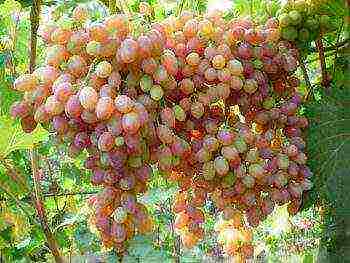
Radiant raisins grape variety
Question number 1. What are the non-covering varieties for the Moscow region?
These are frost-resistant varieties. These include Alpha (withstands up to -40 ºС), Foxberry (up to -35 ºС), Kay Gray (up to -42 ºС), Moore Earley and Valiant.
Question number 2. What varieties near Moscow are suitable for storage and transportation?
Radiant kishmish despite its juicy pulp is suitable for transportation and has good keeping quality. Suitable for storing summer Muscat and Tason varieties.
Question number 3. How to increase the resistance of grapes in the Moscow region?
For the processing of grapes in the fall, the bacterial preparation Mizorin is used. It increases resistance to drought and frost, speeds up ripening by two weeks and increases yields. The product protects the bush from rot.
Question number 4. Which varieties have high taste characteristics?
The first place in terms of taste is Kishmish Radiant, then Cardinal Lux, Shunya, Laura, Arcadia and Nadezhda Aksayskaya. The fruits are sweet and juicy.
Question number 5. What are the high yielding varieties?
In the climatic conditions of the Moscow region, Tason, Kishmish Luchisty, Rusven, Crystal and Agat Donsky give a good harvest.
Gardeners' mistakes in choosing grapes
We offer gardeners' mistakes in caring for grapes in the Moscow region:
- Two factors affect the yield and growth of grapes in the Moscow region: water and nutrients. Since the groundwater is located close to the soil surface, the grapes are practically not watered.
- Nitrogen fertilizers are not used. They reduce resistance to mildew and stimulate the growth of vines, which do not ripen by the beginning of the autumn frost. This leads to freezing of the bush and a low yield.
- For grapes in the Moscow region, the best soil is light sandy loam. It warms up quickly in the spring and cools down in the fall. Due to this, the plant has time to mature and prepare for frost.
- Grape varieties with poor frost resistance, for example Kishmish, are sheltered not only for the winter, but also for the period of spring frosts.
Rate the quality of the article. We want to be better for you:
Everyone loves grapes - and not only residents of the southern regions.Modern selection provides gardeners in cooler climates with the opportunity to grow this healthy and tasty berry. For example, residents of the middle zone and the Moscow region can choose from a variety of quite fruitful and tasty varieties.
To facilitate the difficult task, in the article we will find out how to choose the best grape varieties for the Moscow region, we will give an overview of the most suitable varieties.
Review of the best varieties
We will give a description of the most popular grape varieties among gardeners of the middle zone and the Moscow region.
Lydia

Photo:
A mid-ripening variety - the harvest is harvested 150-160 days after the flowers appear. The bush is medium, the clusters are not large - one bunch weighs about 100 grams. Productivity - 40 kg per bush. Lydia boasts quite large berries - a beautiful regular oval shape, dark red with a waxy smoky bloom.
The taste of berries is sweet with a noticeable sourness, quite harmonious. The sugar content is 19-20%. The main feature and distinctive feature is the strawberry flavor. The variety is interesting in that the longer it ripens, the sweeter and richer the taste of the berries is.
The Lydia grape is resistant to the main diseases of the culture - mildew and oidium, and quite normally tolerates waterlogging of the soil. The variety is frost-resistant, capable of withstanding temperatures up to -26 degrees without shelter. In the south of the country it grows as a non-sheltered one, however, in the Moscow region it is better to protect it from freezing.
Marshal Foch
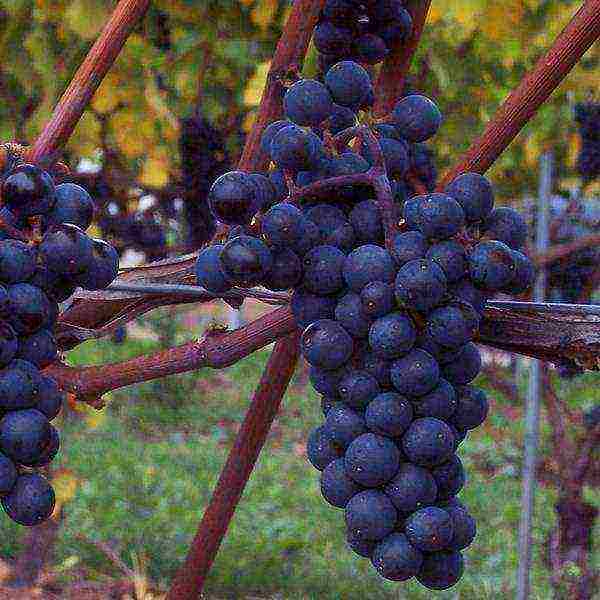
A variety that produces beautiful dark purple berries with a wonderful aroma. Marshal Fon is distinguished by early ripening, which is important for the climate of the Moscow region. In this case, the crop can be harvested 125 days after flowering.
The berries have a sweet, full-bodied taste with a low level of acidity. In addition, the fruit is also very juicy, so the variety is suitable for making juices and wine. The bushes are quite frost-resistant, capable of withstanding up to -30 degrees.
Jupiter
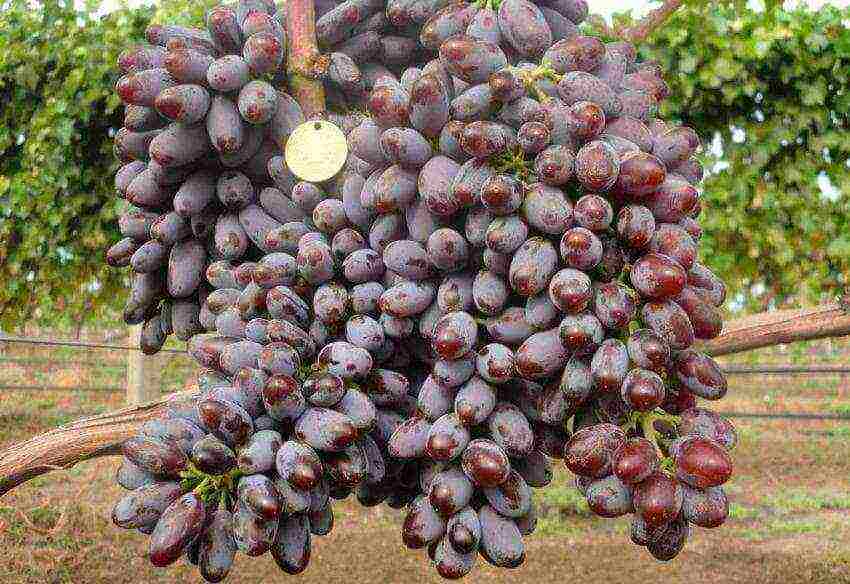
An early maturing variety that is capable of producing a crop just 110 days after the start of flowering. The bushes are medium in size, but with rather large brushes - the weight of one brush is from 300 to 500 grams. The color of the fruit is red-violet, sometimes blue. The berries are large, elongated, juicy and sweet with a nutmeg flavor. Sugars in fruits are about 21%, but more often.
Frost resistance is quite at the level - up to -27 degrees without shelter. In addition, the Jupiter variety has a high resistance to fungal diseases.
Victoria
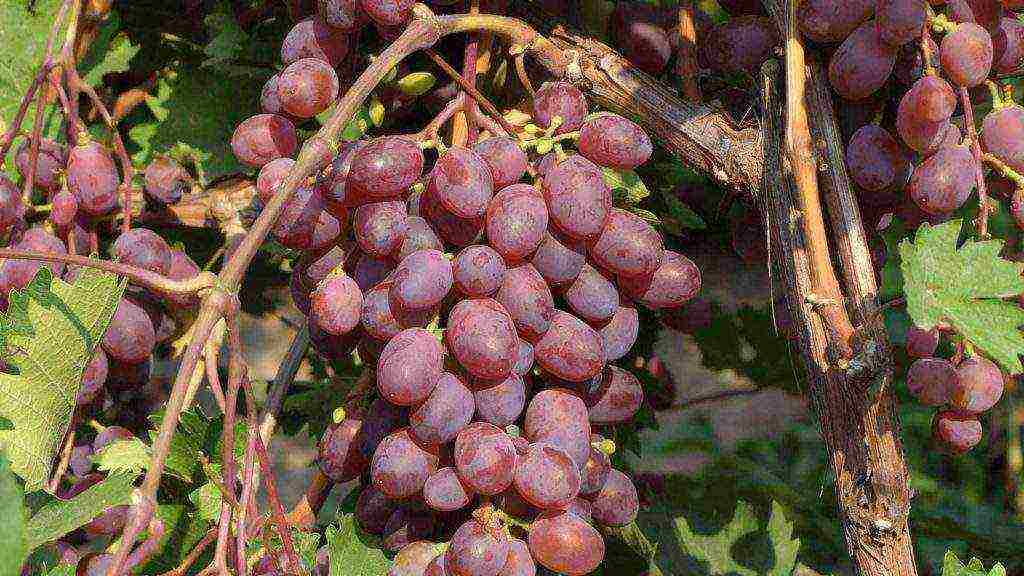
A variety for dining purposes, very popular among gardeners. The shade of large berries is raspberry red, the taste is rich, sweet, slightly nutmeg. The crop ripens early - 120 days after flowering.
Victoria grapes are able to withstand frosts down to -27 degrees, they are distinguished by high yielding qualities. In addition, the variety is resistant to the main "grape" diseases - mildew, gray rot and powdery mildew.
For the winter in the Moscow region, this shrub is usually not covered - especially if the grapes are already mature. Care is rather difficult, since for good yields in this case, it is imperative to thin out bushes prone to thickening. Another disadvantage is the need to plant a number of additional grape varieties for pollination.
Alpha

The variety is distinguished by excellent frost resistance, which is very important for cultivation in the Moscow region. The bush is able to withstand frosts down to -35 degrees. Medium late litter - the crop is harvested 140-150 days after the beginning of flowering.
The bush grows tall, spreading, with long vines, whips, leaves, bunches and berries are of medium size. The brushes are cylindrical, dense, the berries are round, dark blue with a waxy coating. The pulp has a sour taste with strawberry notes. The variety has a high yield, which even increases with careful care. On average, 7 to 10 kg of berries are harvested from one bush.
The variety is highly resistant to aphids and fungal diseases, however, it is not resistant to chlorosis. You can use the vine as a decorative frame for arbors, trellises, walls of buildings.
Anniversary of Novocherkassk
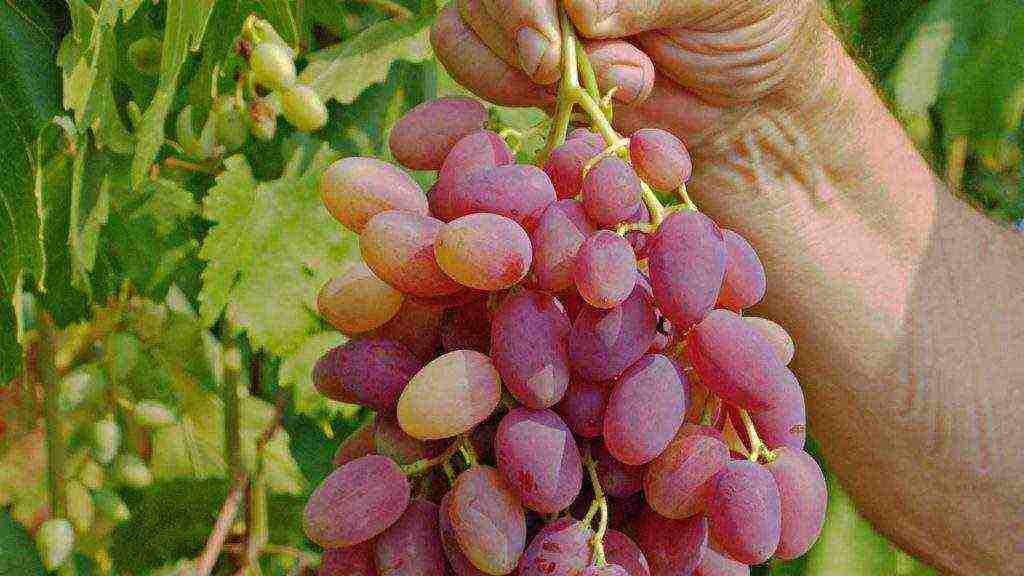
One of the most popular varieties in our country - it is distinguished by high frost resistance and excellent yield. The variety is able to withstand temperatures as low as -30 degrees without shelter. In addition, the Novocherkassk Jubilee ripens early and produces very large clusters, the average weight of which is about 3.5 kg.
The fruits are sweet, their skin is tender and almost not felt. Also, the berries are crispy, juicy, the pulp is dense, fleshy. The color of the fruit is pale pink. The variety has a high resistance to the most common grape diseases. In care, the shrub is unpretentious, adapted to the realities of our climate, soil characteristics.
Aleshenkin
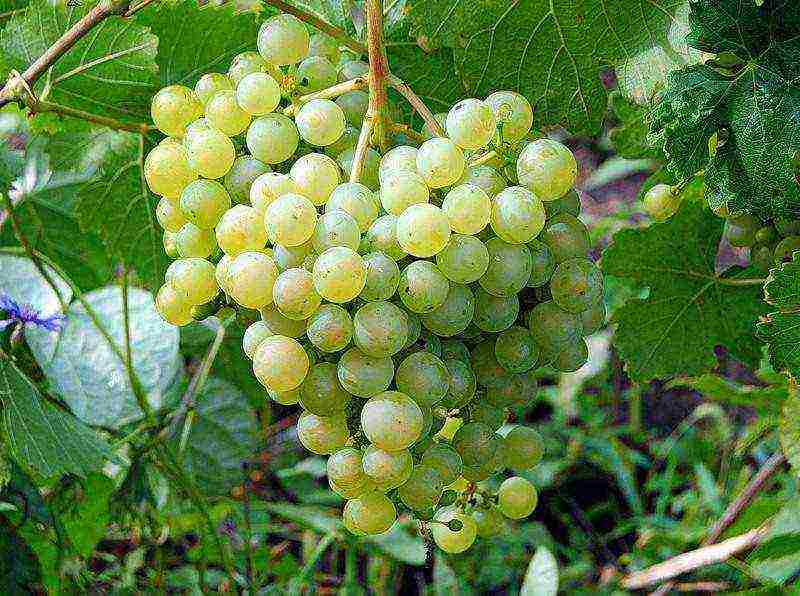
Early ripening variety - yields a harvest 118 days after flowering. The brushes are large, conical, the average weight of one is from 700 to 1500 grams. Experienced gardeners grow brushes and weigh up to 2.5 kg.
The berries themselves also have quite decent sizes and weight from 3 to 5 grams, they are distinguished by a beautiful oval shape, a greenish-golden color with a weak waxy bloom. Every second berry on the hand has no bone.
The fruit has a very pleasant taste, sweet and harmonious - a true standard for table grapes. In addition, the Aleshenkin variety is also frost-resistant - it can calmly withstand temperatures down to -26 degrees.
Minus - weak resistance to fungus. It is especially dangerous to grow this grape in a climate with frequent rains and slush. In order to avoid fungal pathologies, it is recommended to process this variety every two weeks with the necessary preparations.
Super Extra

The variety is table and high-yielding. Well suited for growing in the climate of the Moscow region and the middle zone, it is able to withstand frosts up to -24 degrees without shelter. Resistant to major grape diseases.
Super Extra has an early ripening period and produces large berries weighing 8-9 grams each. During the season, one bush brings up to 16 kilograms of harvest. The berries are distinguished by excellent keeping quality and excellent transportability.
Kuderka
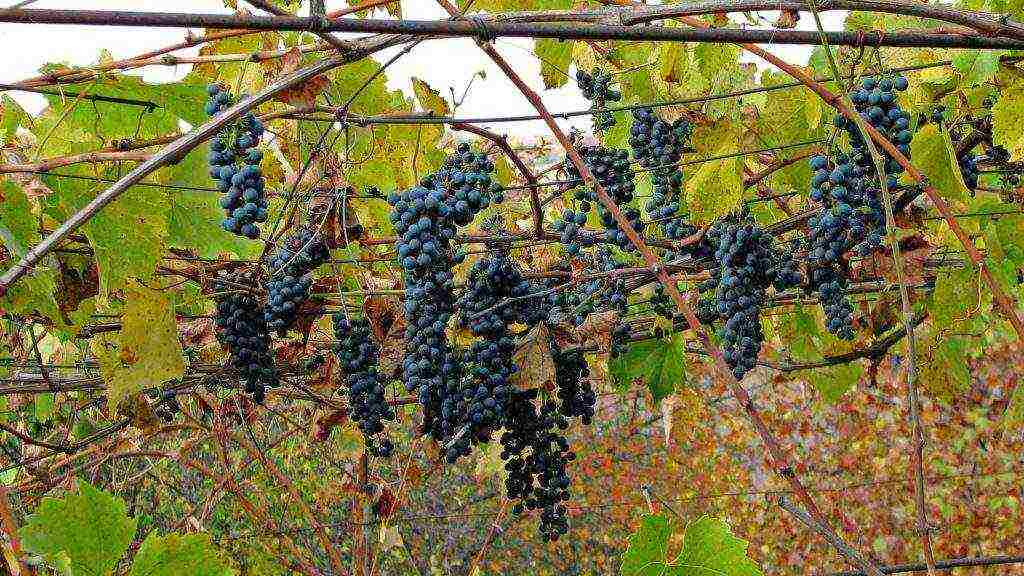
The variety has one more name - "Kudrik". This grape has a truly unique yield - up to 100 kg per bush per season. Fruits are sweet, dark blue - wine can be made without additional sugar.
The brushes are of medium size and cylindrical in shape, weighing about 300 grams. The variety is unpretentious, undemanding to external conditions and soil, tolerates frosts down to -30 degrees, and is easy to care for.
In addition, the variety is resistant to fungus, but may be susceptible to phylloxera. To avoid the latter disease, it is better to pre-spray the shrub with appropriate preparations.
Flora (Laura)
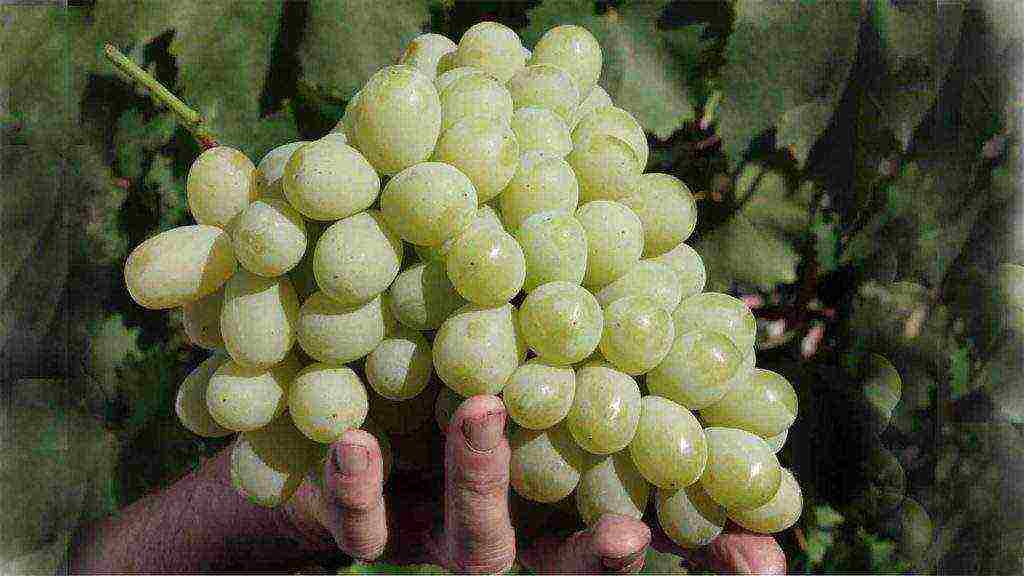
Table grape, has an early ripening period (110 days), gives beautiful light green berries. The variety has a relatively high frost resistance - it can tolerate up to -23 degrees without shelter.
The berries are fleshy, dense, their taste is pleasant, the weight is decent - up to 15 grams. Until the harvest, the fruits sit on the branches without crumbling, the bunches are large - up to 2 kg. Plant immunity is average.
Nadezhda Aksayskaya
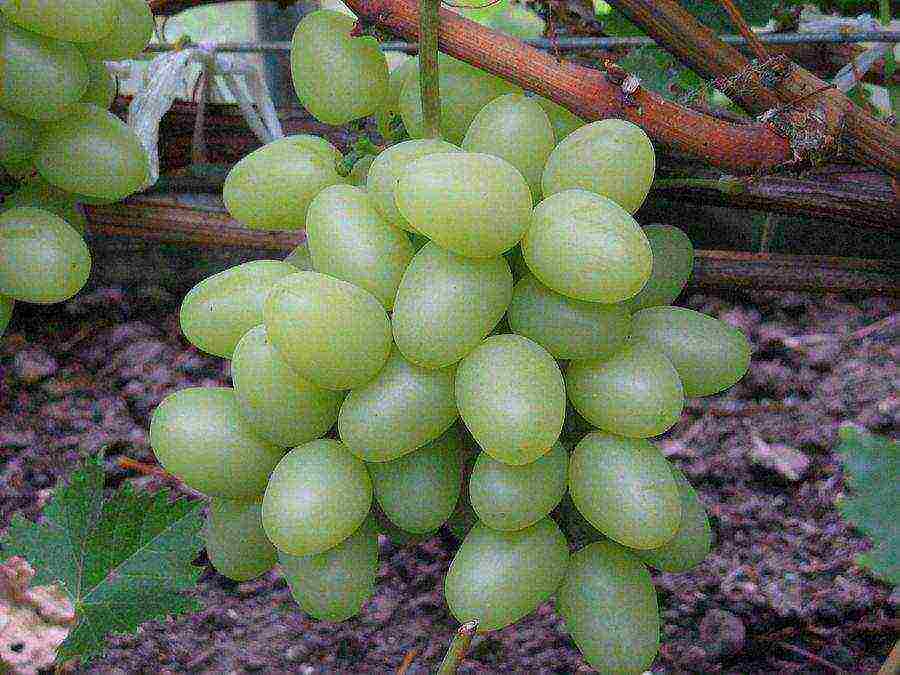
A table variety that produces large white berries with a sweet taste. It is very popular among gardeners near Moscow due to its adaptability and unpretentiousness, as well as decent yield.
Ripens early - you can harvest as early as 120 days after flowering. Morozov Nadezhda is not afraid and is quite capable of surviving a cold snap to -25 degrees without shelter. The berries grow large (up to 12 grams), sweet, when fully ripe, a characteristic nutmeg flavor is felt.
The variety is good because it does not need greenhouse cultivation at a young age - it takes root well immediately in the open field.Disease resistance is average, so spraying from rot and powdery mildew is necessary.
Crystal

The so-called technical variety grown for the preparation of table white wines and sherry. A high-yielding culture, and even in the climate of the Moscow region gives large, dense clusters with many berries.
The crystal has a high resistance to fungus, tolerates frosts down to -29 degrees. The berries are yellow-green, with a dense skin and a pleasant, harmonious taste. The mass of one berry is about 2 grams. Early ripe variety - harvest is ready 115 days after flowering. The bush itself grows medium, but stocky, dense.
Harmony
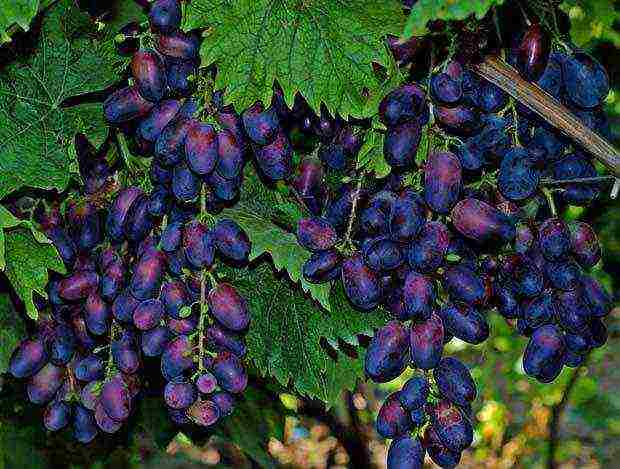
A mid-season variety, the harvest of which is used for making wine and preserving. It is very hardy, unpretentious and has excellent immunity.
The berries are medium-sized, but juicy and very tasty. The color is dark blue, which makes it possible to make wonderful wine drinks with a beautiful ruby hue
Buffalo
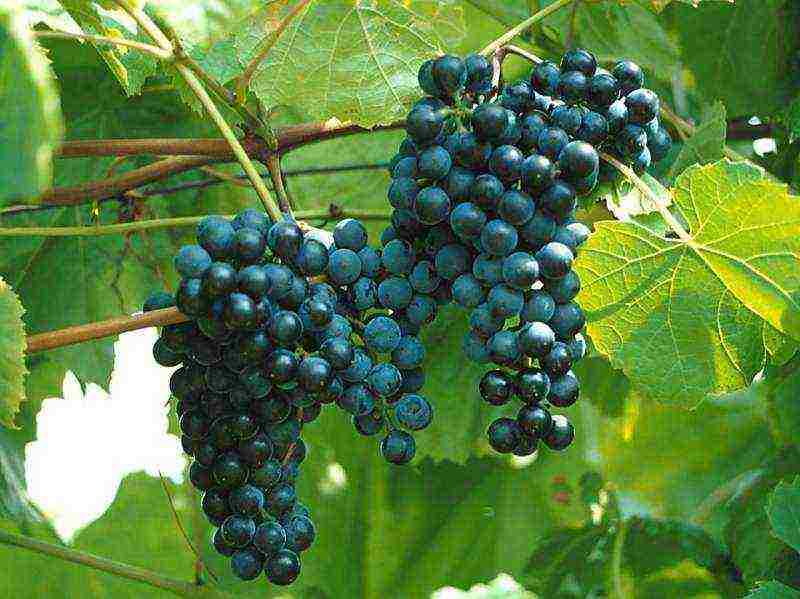
An early ripe variety, ripens in the Moscow region by about mid-September. The shrub grows strong, powerful, even young growth tolerates frost well. The yield is high.
The brushes are conical, dense, their size is medium. The berries are large, have a regular rounded shape, gray-black color with a touch of haze. The taste of the fruit is sweet, harmonious, you can feel the taste of pear. The sugar content is 18-21%.
The shrub tolerates frosts quite adequately - up to -28 degrees without shelter. Also, the plant is a little sick, is not susceptible to putrefactive and fungal pathologies. The harvest is used for the preparation of table wines, the most delicious juices are also obtained from these grapes.
Phenomenon
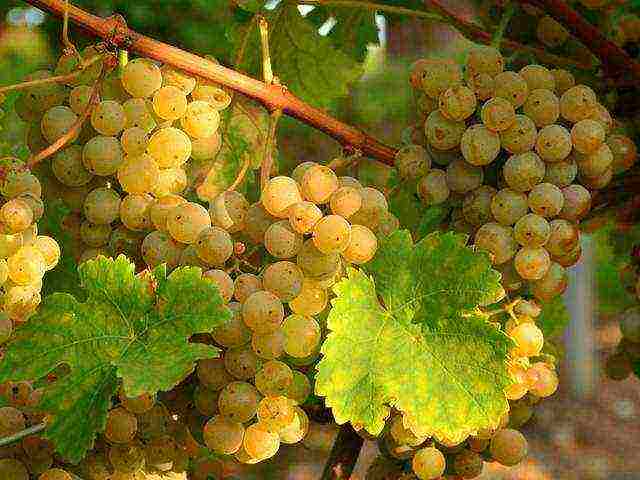
Table variety, characterized by large cone-shaped bunches, weighing from half a kilogram to one and a half each. At the same time, the bush reaches an average height. The berries have a light yellowish color, a regular oval shape and a great sweet and sour taste. Sugar content is high - 20-22%.
In the Moscow region, the harvest of this grape variety ripens from the second half of August to mid-September. An adult plant is quite frost-resistant, young growth must be covered for the winter.
Kishmish Radiant
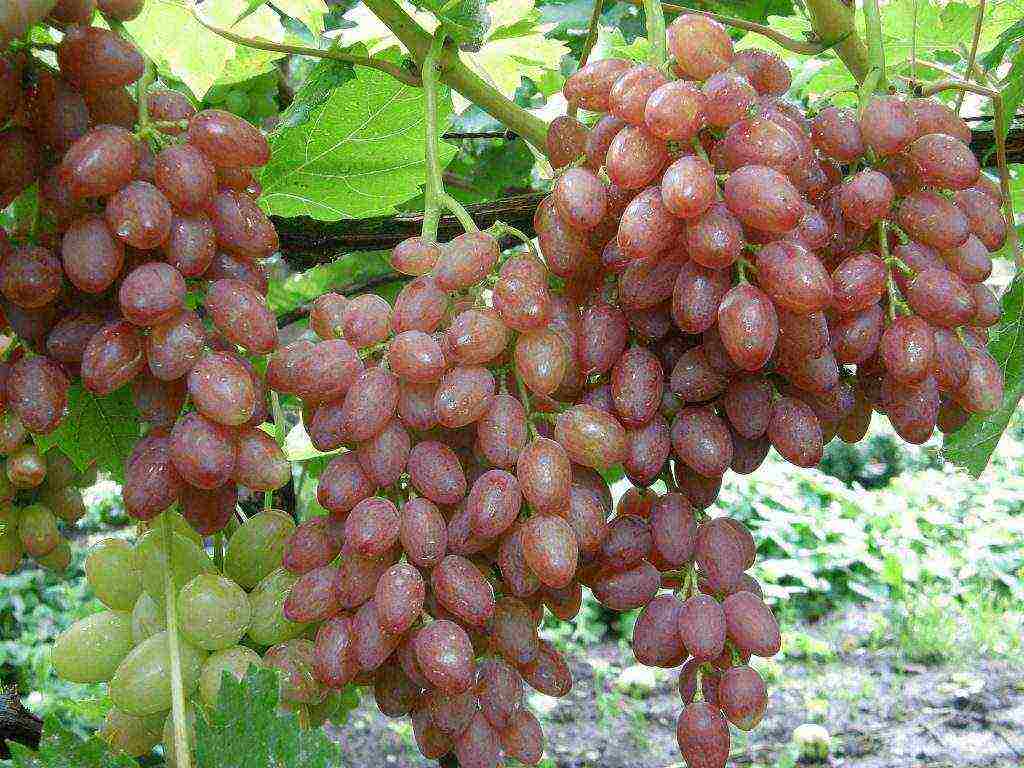
The variety was bred by Moldovan breeders, frost-resistant, harvestable and is quite suitable for cultivation in the climate of the Moscow region. The average weight of a bunch reaches a kilogram, the berries are large and sweet, have a beautiful pink tint and a nutmeg flavor. Almost all the shoots of the bush bear fruit, which makes it possible to collect record yields.
In addition to the listed varieties, we will briefly note some more - also worthy of the attention of winegrowers in the Moscow region.
Beauty of the North
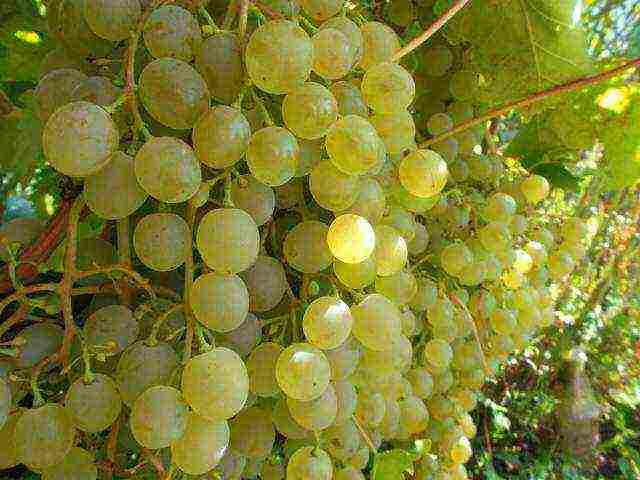
Fast ripening table grapes, hardy. Some consider the taste of its berries to be overly tart - and this is the main disadvantage of the variety.
Tason
The variety is distinguished by its particularly large berry size. The fruits, in addition, have a pronounced nutmeg taste and a beautiful, elegant appearance, a white-pink hue.
Christina
A medium-ripening variety, unpretentious and tasty.
Isabel
A famous variety that is grown for the preparation of delicious dark red wine. Isabella is also grown in the Moscow region - but for the winter the shrub requires an obligatory shelter.
Muscat
It is also a wine variety, widely used for making champagne and white wine. The downside here is that the crop ripens late, and the shrub needs a mandatory shelter. However, they are grown in the climate of the middle zone and it.
Landing features
Scheme (photo):
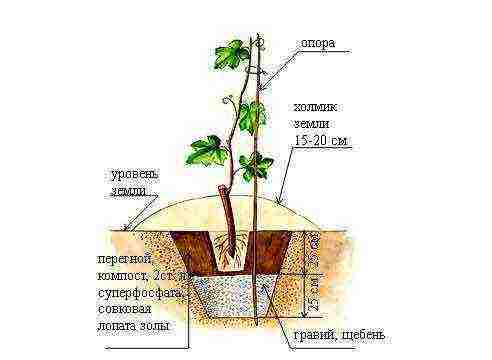
Let's clarify the main points regarding the rooting of grapes in the Moscow region.
Time
Since in the Moscow region the first frosts can come early, the spring period of grape rooting is more suitable for this region. The best choice is the second half of April. If, nevertheless, stop at the autumn planting, it is better to choose October, when it is still quite warm, and the shrub will have time to take root before frost.
Seedling selection and processing
For spring planting, we recommend purchasing a grape seedling also in spring - the end of March or April is the best fit. A high-quality seedling should have a branched root system - light in color and without damage. Before planting, it is necessary to soak the roots of the seedling and spray it all with a phylloxera aphid preparation.
Seat selection
The best soil for grapes is black soil. Since there is a problem with such lands in the Moscow region, the garden bed must be thoroughly fertilized and fertile before planting grapes.
It is important to mix more sand into the soil so that the soil acquires a loose, light structure - optimal for grapes. In lowlands, swampy ground, it is better not to try to grow shrubs - there will be no harvest, only disease and death of plants.
It is also important to provide protection from the north wind and drafts. Therefore, the best landing is under the protection of the walls of buildings, fences from the leeward side.
How to plant?
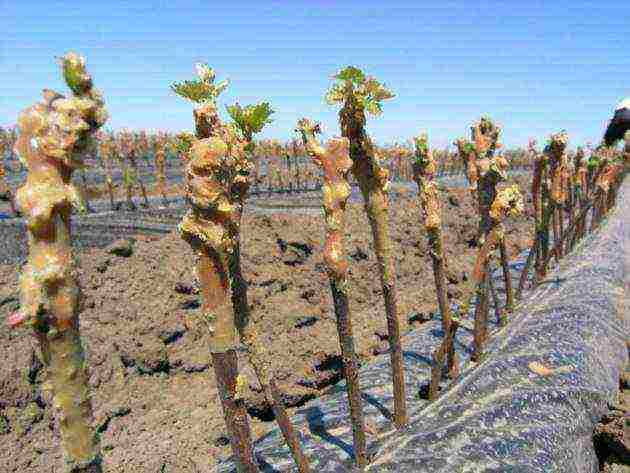
Grapes can be planted in three ways:
- into the pits;
- in trenches;
- into high ridges.
Pits
If we talk about the first method, then it is the most suitable for amateur cultivation. For most varieties, a pit with parameters 80x80x100 is suitable, where 100 is the depth.
Trenches
Trench planting is more suitable for industrial cultivation of grapes, as it allows you to plant many bushes at once. But the method can also be used in the case when the soil is sandy, loose. Trenches are dug 80 cm deep and a meter wide. The location is from the south towards the west.
High ridges
The method is suitable if the soil is too dense, poorly permeable, clayey. In this case, it is necessary to build rather high embankments (about a meter), on which grapes are then planted.
Care
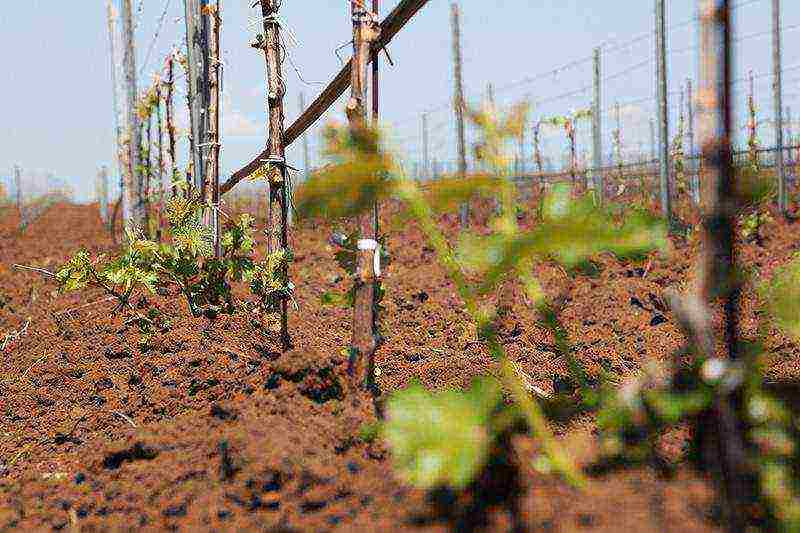
Lighting
In order for a culture to successfully bear fruit and ripen in a difficult climate, it is necessary to provide it with a place with long and abundant lighting. No shady areas - the berries simply will not ripen there. It is optimal to plant grapes in the south and southwest.
Top dressing
Without fail, the bush needs additional nutrition. The plant needs both organic matter and minerals.
Loosening
In order for the culture to feel well and bear fruit, it is necessary to provide it with a constantly loose, light soil. Simultaneously with the loosening procedure, free the garden from weeds.
Watering
The grapes need abundant moisture - water is needed both for the health of the shrub itself and for pouring large berries. In one procedure, at least three buckets of water are consumed per bush at a frequency of twice a month.
However, if the summer turned out to be cool and rainy, which is quite typical for the Moscow region, it is recommended to reduce the frequency and abundance of watering.
Pruning
Vine bushes need shaping - pruning allows you to make the shrub more fertile, compact. Usually, the culture is formed in a fan-like manner - it allows the largest number of bunches to ripen.
Wintering
Young grape seedlings are covered without fail, and of the adults, only those that cannot tolerate severe frosts are usually very early varieties.
The root circle is covered with burlap or agrofibre, as well as a mulch layer of 5-7 cm sawdust. The scourges are laid on the ground, pressed with fallen leaves, spruce branches, boxes. In the spring, as soon as the sun begins to noticeably warm, the shelters must be removed so that the grapes do not rot.
We found out what grape varieties can be grown in the Moscow region. As you can see, the choice is quite decent - there are varieties that are both fruitful, and resistant to diseases / frosts, and especially sweet, and not covering, and unpretentious. Having decided on the choice, do not forget to properly care for the grapes - and then the annual bountiful harvests of delicious berries will be provided.
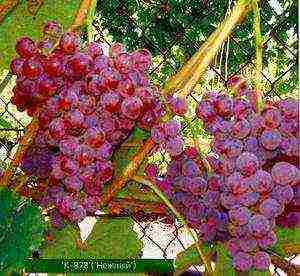 Grapes are one of the most thermophilic plants that loves to be carefully looked after and taken care of.Gardeners who decide to breed it in the northern regions have to face various difficulties and make efforts to get a good harvest.
Grapes are one of the most thermophilic plants that loves to be carefully looked after and taken care of.Gardeners who decide to breed it in the northern regions have to face various difficulties and make efforts to get a good harvest.
But not everything is so bleak. Over the past few years, as a result of the hard work of breeders, many uncovered grape varieties have appeared, which are resistant even to severe winter cold.
The climate in the Moscow region can be compared with the northern regions of the country. Autumn frosts and long winters force gardeners to look for the best uncovered grape varieties for harvesting. We will consider the most popular and frost-resistant ones below.
Good non-covering grape varieties for the Moscow region
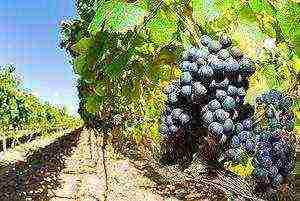 Frost-resistant varieties the plants fell in love with winegrowers immediately after their appearance. It is not hard to guess that it is much easier to care for them in the northern regions. They do not need to be covered or specially prepared for the onset of winter. Growing grapes with such characteristics is much more profitable for summer residents, and much less physical strength is required for growing. Often these types of plants are chosen by novice gardeners, and this is right, therefore, with a minimum of effort to care for it, you can get the maximum result. Uncovered grapes has immunity not only to cold, but also to pests and diseases.
Frost-resistant varieties the plants fell in love with winegrowers immediately after their appearance. It is not hard to guess that it is much easier to care for them in the northern regions. They do not need to be covered or specially prepared for the onset of winter. Growing grapes with such characteristics is much more profitable for summer residents, and much less physical strength is required for growing. Often these types of plants are chosen by novice gardeners, and this is right, therefore, with a minimum of effort to care for it, you can get the maximum result. Uncovered grapes has immunity not only to cold, but also to pests and diseases.
Breeders have bred a lot of good varieties suitable for growing not only in the Moscow region, but also in more northern regions. Their productivity is no worse than that of more whimsical species. Grapes for the Moscow region can be selected according to various criteria, such as immunity to diseases, ripening period and temperature conditions at which the plant can not be covered.
"Anniversary of Novocherkassk"
This variety is considered the most popular among uncovered grape varieties. In any rating of frost-resistant varieties there is a place for it. It can be safely planted in the suburbs. The temperature to which this variety can adapt without shelter is in the range of -25 to -30 degrees. Its biggest advantages are early ripening and very large clusters, the weight of which can reach 3.5 kilograms.
When eating its fruits, the skin is not felt at all, the taste is very pleasant, rather sweet. Oval berries are juicy and crispy, pale pink in color with a shimmer. "Jubilee of Novocherkassk" has a high immunity to various kinds of infections and diseases. It is very simple to care for it, the variety is unpretentious, and it brings a large harvest every year. For him, you do not need to specially prepare and fertilize the site..
"Jubilee Novocherkassk" is well suited for propagation by cuttings, which quickly take root in almost any climatic conditions. They can also be grafted onto other bushes, while obtaining a plant with high yields and non-covering properties. You need to take care of seedlings only in the first 3 years of life until a strong root system is formed.
"Kishmish Radiant"
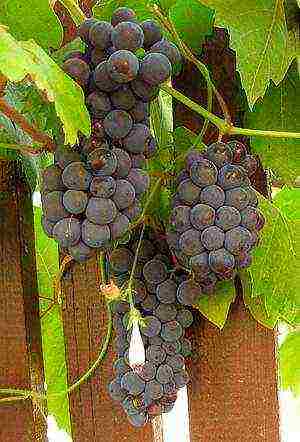 This grape variety for the Moscow region is known all over the world for its taste and high yield. On its basis, breeders are developing more and more new plant species. Its frost resistance is not as high as that of the Novocherkassk Jubilee, but this is not the main reason why beginners and experienced gardeners choose it. In the northern regions, you still need to cover the bushes.
This grape variety for the Moscow region is known all over the world for its taste and high yield. On its basis, breeders are developing more and more new plant species. Its frost resistance is not as high as that of the Novocherkassk Jubilee, but this is not the main reason why beginners and experienced gardeners choose it. In the northern regions, you still need to cover the bushes.
Bunches begin to ripen early, literally in 4-4.5 months, depending on weather conditions. The color of the berries is pink-purple, the taste is very rich and soft, moderately sweet. The berries are quite large, up to 2 cm in diameter and weigh about 7 grams. Harvesting usually begins between 15 and 25 August, and up to 1 kilogram of the crop can be harvested from one bunch. It can be easily transported and stored.
The "Kishmish Radiant" has a number of disadvantages that must be taken into account before landing in the Moscow region:
- Low non-covering properties: the temperature that the bush can withstand without shelter is not lower than -15 degrees.
- It is not recommended to open it in early spring, the spring frosts can harm the bush.
- Careful care and constant formation of the bush is needed.
- The taste of berries depends on the application of fertilizers of frequent watering; without them, the taste is lost.
"Tason"
This table type differs from the rest by the active growth of vines in height. A record number of berries can be obtained from one bush. "Tason" belongs to the early varieties, for the full ripening of the bunches it takes only 95-110 days. Even in the coldest northern regions, you can get your first crop before mid-spring. Half shoots from all over the bush - fertile branches, from each of which you can get up to 4 kilograms of berries.
On large clusters weighing from 0.5 to 1.3 kg, oval-shaped berries of white-red color grow. This is one of the sweetest grape berries among the uncovering varieties. Growers choose this variety for cultivation for sale, the harvest from it can be easily transported and conveniently stored.
As for frost resistance, it is considered one of the highest. It is only necessary to cover the bushes if the temperature has dropped below -23 degrees. Tason has a high resistance to diseases, especially for powdery mildew, however, there is no such high immunity against fungi.
"Crystal"
 Good technical grade, suitable for making juices, wines and other food and drinks. It is highly valued by winemakers for the content of the required amount of sugar in berries. Small brushes, up to 200 grams, oval berries are also small and uniform in size. In the process of maturation gradually change their color from green to pale yellow.
Good technical grade, suitable for making juices, wines and other food and drinks. It is highly valued by winemakers for the content of the required amount of sugar in berries. Small brushes, up to 200 grams, oval berries are also small and uniform in size. In the process of maturation gradually change their color from green to pale yellow.
Vines of "Kristall" do not grow very tall, but at the same time they give a lot of yield. Almost all shoots bear fruit and can grow from 50 to 60 eyes. For technical purposes, "Kristall" is ideal, even despite the small size of the berries. Its most important quality is the quantity of the crop. High quality and tasty dry wines from this variety can be prepared even in the suburbs.
Depending on the weather, the vegetative period of "Kristall" can last from 110 to 130 days, so it belongs to the early varieties. The temperature at which it is possible to grow the "Kristalla" grape bush without shelter reaches -30 degrees, which favorably distinguishes it among the uncovered grape varieties.
With all the indisputable advantages of "Kristall", it also has a number of disadvantages:
- Leaves and shoots must be constantly pruned to form a bush. If this is not done, the crop may crumble from the branches until it is fully ripe.
- Despite its resistance to some diseases, the variety cannot boast of immunity to fungal infections, so it needs to be processed regularly.
- Wet and cold weather during the ripening period can lead to a deterioration in their taste. This reduces the share of the crop suitable for making drinks.
"Christina"
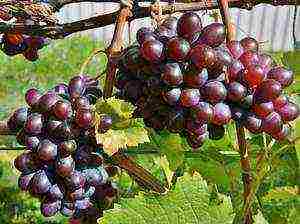 This is one of the most popular uncovered grapes, suitable for the climate of the Moscow region. Grape growers love it for its good taste and moderate sweetness. With a sufficiently high frost resistance the plant does not require special care even in the most capricious climates. It can withstand low temperatures down to -25 degrees.
This is one of the most popular uncovered grapes, suitable for the climate of the Moscow region. Grape growers love it for its good taste and moderate sweetness. With a sufficiently high frost resistance the plant does not require special care even in the most capricious climates. It can withstand low temperatures down to -25 degrees.
Appearance of Christina berries - this is one of the traits for which everyone loves this species. There are no small clusters on the vine; they are all large and conical in shape. Oval-shaped berries of bright pink color with a shimmer. Their only drawback is that the berries are not always the same size on the same bunch.
"Pearl Saba"
The type "Pearl Saba" is the result of painstaking work of Hungarian breeders. He quickly won a place of honor among everyone's favorite grape varieties for the Moscow region. Even beginners in gardening know him.
The reason for this popularity became the ability to quickly get used to any climatic conditions and good frost resistance. In winter, you may not cover this variety if the temperature in the region does not drop below -28 degrees. "Pearl Saba" is immune to pests.
Large clusters grow juicy berries, very sweet and aromatic. The bushes look very impressive due to the bright green clusters.
"Isabel"
The second name of this variety, known to many gardeners, is "Lydia". It is often used in winemaking for making white wine due to its high tannin content.
"Isabella" has good qualities, therefore it is suitable not only for technical use, but also for dining. Small berries taste very unusual, when consumed, you can feel the strawberry aftertaste.
With careful care of a bush from one bunch, you can get up to 2 kilograms of a good harvest. If you wait until ripening, you can also collect red-blue berries from the bush.
Due to its high frost resistance, "Isabella" is popular among gardeners in the Moscow region. The temperature, which the bush tolerates well without shelter, reaches -28 degrees. In addition to frost resistance, this species can boast of high immunity to pests common in the Moscow region: oidium and mildew.
"Transfiguration"
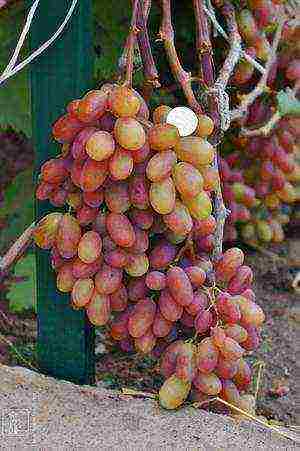 "Transfiguration" is considered a new variety, but it has already established itself as a grape with the ability to quickly take root. It ripens very quickly - from 100 to 120 days.
"Transfiguration" is considered a new variety, but it has already established itself as a grape with the ability to quickly take root. It ripens very quickly - from 100 to 120 days.
The bunches are large enough, can reach weights from 0.5 to 2 kg. Large berries grow on them. The average weight of one grape is 15 grams. The color of the bunch is pale pink, the bush looks very beautiful due to the fruits.
The taste is not inferior to the appearance. It is very tender, moderately sweet, but at the same time with a slight sourness. Gardeners note the good yield of the grape bush: from it you can get up to 18 kilograms of sweet fruits.
The undoubted plus of "Preobrazheniya" is its high frost resistance, up to -25 degrees without shelter. Immunity to fungal infections is average, so you need to periodically carry out measures to prevent diseases. The disadvantage of this variety is its attractiveness for wasps due to the sweetness of the fruit. Talso in areas with high humidity the quality of the fruit can deteriorate dramatically.
Features of caring for uncovered grapes in the Moscow region
Before planting frost-resistant grapes, you must familiarize yourself with all its features:
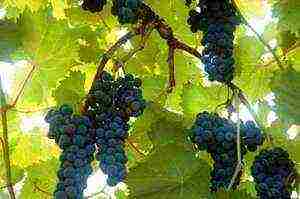 For cultivation, you need to select areas with good lighting. This recommendation especially applies to gardeners who grow grapes in the northern regions of the country and in the Moscow region. If there is not enough sunlight for the plant, the growing season will be much longer. In this case, the quality of the bunches, including their taste, may suffer.
For cultivation, you need to select areas with good lighting. This recommendation especially applies to gardeners who grow grapes in the northern regions of the country and in the Moscow region. If there is not enough sunlight for the plant, the growing season will be much longer. In this case, the quality of the bunches, including their taste, may suffer.- It is better to choose a site for planting on a hill in order to protect the bush from sewage, which can flood it after rains or melting snow. Excessive moisture can cause the root system to rot, which will lead to the death of the plant.
- Before planting, you need to dig a trench in advance. Drainage and a layer of soil are poured into it and left for some time so that the earth is saturated with moisture and minerals.
- When planting seedlings, you need to retreat a sufficient distance between them. It is chosen depending on the grape variety, and it can be from 1 to 2 meters.
- Some gardeners use this trick: they dig a trench next to the roots of the plant and put plastic bottles with holes in it. It is then very convenient to introduce additional food and water through them.
- Regardless of the grape variety, for the first 3 years, the seedlings must be covered with plastic wrap or wooden flooring.
The grape possesses such a unique property as vertical polarity.This means that the bush is growing upward and requires a garter. At the same time, fertile vines tied to horizontal bars so that the bush has the correct shape and develops evenly. If you limit yourself to only vertical tying, then this will negatively affect the shape of the main vine. It will become too long, stopping the growth of the side and bottom shoots.
With regard to watering, you need to be as careful as possible. It is imperative to moisten the soil only for young seedlings that have not reached the age of two, and for all bushes in the fall, in order to saturate the soil with water before winter. It is strictly forbidden to water the vines a week before the end of the flowering period, otherwise the flowers may fall off. This can cause very low yields and small and sour berries.
Some gardeners carry out the procedure for spraying the bushes, but this cannot be done, since as a result of it, infections and bacteria have a chance to reproduce.
A wide variety of hardy varieties grapes allow you to grow it in any regions of Russia, which were previously unfavorable for this plant. Compliance with the rules of caring for various varieties provides even novice gardeners with a good harvest for many years.
>

